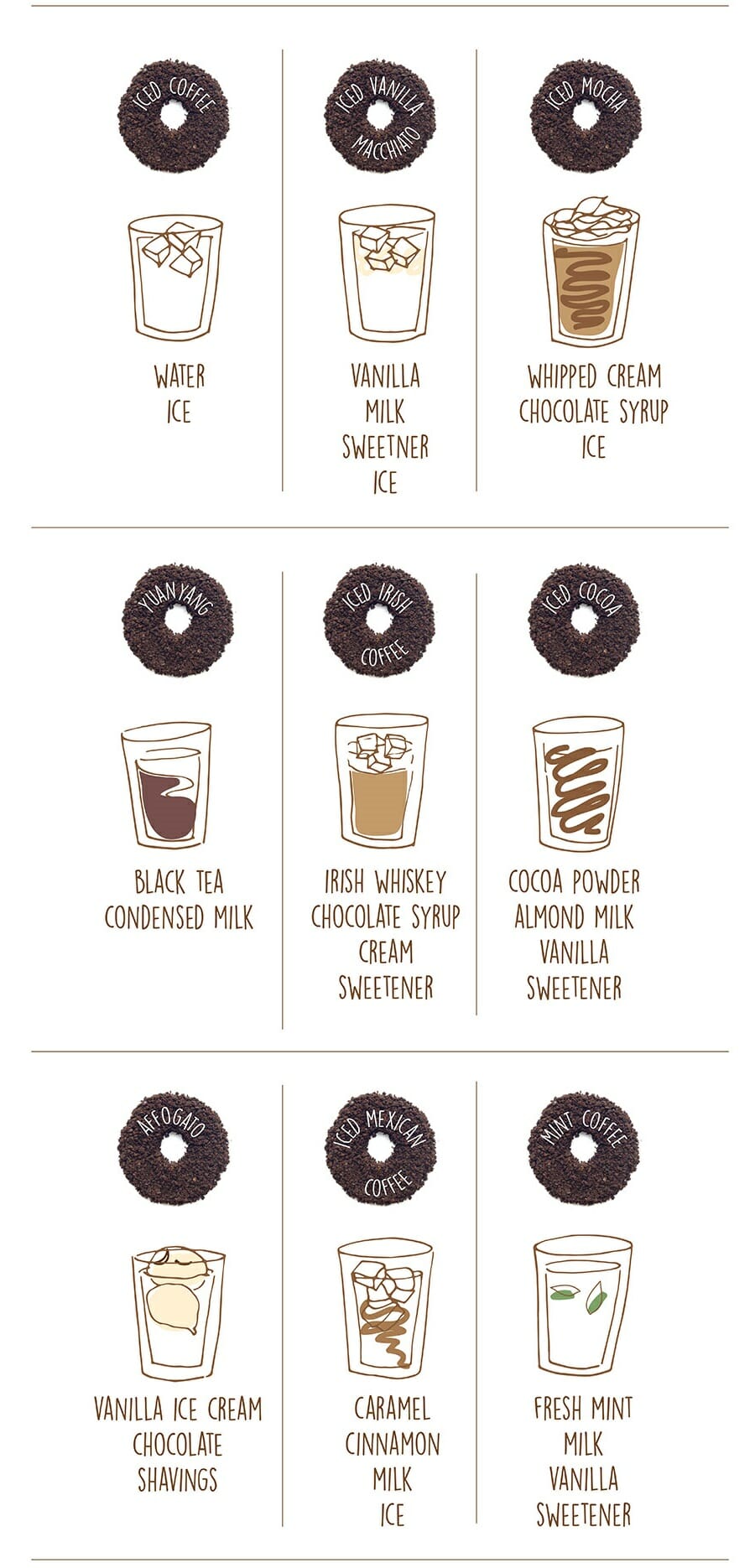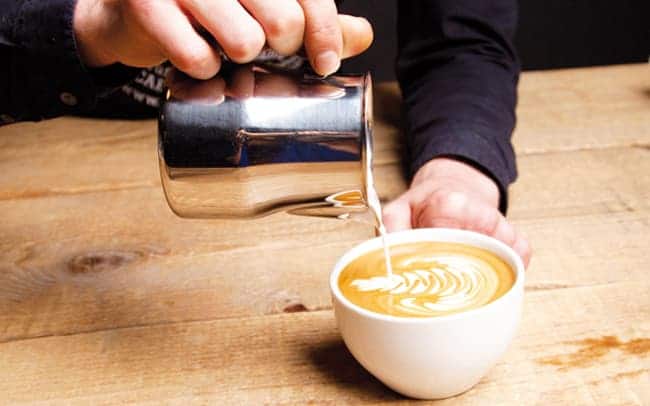Cold brew is a coffee that has been chilled with cold water and left to brew for several hours. Cold-brew is drunk ice cold, preferably on ice cubes.
It can also serve as a base for cocktails. A fruity lemony coffee, mixed with a dash of bitter lemon, served on ice cubes in a tumbler, and garnished with a little rosemary, can be a special treat.
History of Cold Brewed Coffee
Cold-brew is not a new invention,
This type of preparation was very popular in Japan as early as 1600.
The term cold brew has been a common term in the coffee industry for around ten years.
It is a shame that companies today are trying to have such terms registered as a trademark and warning small roasters and coffee operators.
As is so often the case, trendy terms in the coffee industry come from the States.
The normal consumer can hardly imagine anything under the term cold brew. Attempting a translation usually leads to rejection by the consumer.
Terms such as “cold” combined with “coffee” are associated with either cold coffee or iced coffee.
The Process from Plant to Beans
Brewing processes have arisen from technological possibilities and have been continuously improved over time.
The rise of espresso and the advance of steam engines go hand in hand.
Continuous improvements in cultivation, harvesting, and processing in recent decades have resulted in the quality of green coffee increasing steadily.
The need for machines that make these differences visible has increased.
Pressure and temperature stability when brewing espresso is a matter of course today.
The preparation is becoming more and more precise, without scales, you can’t see a professional brewing coffee anymore.
This interplay between technology and production leads to constant further development and improvement in coffee quality.
Better green coffee and the possibility of perfect preparation have led to small roasting plants again.
Pricing
Extra quality goes hand in hand with higher purchase prices, manual processing steps, and longer production times.
That drives up the price, and not everyone wants to pay it.
Not to mention fair prices that allow everyone in the production chain to participate in the added value.
Here, too, it is the small roasters that work ethically and sustainably and that without industrial pseudo-seals, who just pretend. Besides, it is the young who are the drivers of innovation.
Roasting
The type of roasting differs depending on the desired brewing method.
This is primarily because the acids in the green coffee have to be broken down to a certain extent by the roasting process.
The larger amount of water allows a higher acid content in filter coffee, compared to an espresso.
The perfect roast for filter coffee results in an extremely sour espresso.
The perfect roast for espresso is a flat filter coffee.
It is the roasting time and the temperature that influence the degradation of the acids.
Acidity and Aromas
The overall character of a coffee changes with the acids. On the one hand, this has to do with perception – a certain acid content promotes the perception of fruity aromas – and on the other hand, it has to do with the amount of the existing aromas themselves.
The aromas in coffee are divided into three categories: enzymatic, sugar browning, and dry distillation.
Enzymatic aromas arise during the plant’s growth, sugar browning aromas arise from the Maillard reaction during roasting, and dry distillation aromas arise from the combustion of the pulp of the coffee bean.
The enzymatic aroma is floral, fruity, and reminiscent of herbs, sugar browning aroma is nutty, caramel-like and chocolate, dry distillation aroma is spicy resinous, and burnt (carbon).
During the roasting process, the enzymatic aromas are broken down, creating sugar browning aromas.
In the further course, the enzymatic aroma disappears, and sugar-browning aroma and dry distillation aroma emerge.
Even further in the roasting process, the sugar browning aromas disappear,
The need to control acidity goes hand in hand with the flavors coffee harbors.
This explains the trend towards more acidic espressos, where the flavors are more complex, at the price of higher acidity.
It also explains why filter coffee can be more interesting because it has to pay more attention to the flavors and less to the acidity.
But What Does it Mean for Cold Brewed Coffee?
The “little” digression was necessary to understand why cold brew can make such a delicious drink.
By brewing at cold temperatures, acids and bitter substances dissolve to a much lesser extent.
The coffee used can and should be acidic.
Using high-quality green coffee also means more aromas and complexity.
Low-acid roasting and roasting of inferior green coffee are taboo.
Cold-brew is good when you use exceptional filter coffee, the fruity, the better.
Roasts that are too dark produce a glass of cold, burnt, and bitter water, without any special aromas.
Coffee that is too simple results in a meaningless kind of drink.
The right coffee, on the other hand, produces a tangy, fruity drink,

On your Marks, Set, Brew!
Here are the requirements for making a wonderful cold brewed cup of coffee.
Dosage
Cold-brew requires a significantly higher dose of coffee compared to conventional filter coffee.
The rule of thumb for filter coffee is that 60 grams of ground coffee are used for one liter of water.
With Cold Brew we can increase this significantly, 80 grams is a good start, but it can also be more.
The nice thing is that increasing the dose increases the aroma density, with only a moderate acidity increase.
The use of acidic roasts also means that the enzymatic spectrum’s aroma emerges in the finished drink, even more than filter coffee.
Timing
Cold-brew takes anywhere from six to 24 hours.
In general, when it comes to brewing time, short times emphasize enzymatic flavors and long brewing times dry distillation flavors.
Short brewing times require a higher dose, longer brewing times a lower one.
Grind
The grind should be coarser for a higher dose and finer for a lower dose.
Basically, the grind for cold brew is the same or coarser than that for filter coffee.
You can check out our article on grinding for espresso here.
An important factor in the production of cold brew is fines. These are the finest particles that are created when grinding.
These are significantly smaller than the particles of the set grinding degree. With espresso, fines are essential to reduce the flow rate of the water through the coffee puck, they seal the coffee puck.
With filter coffee and cold brew, however, these are annoying.
Fines extract much faster, produce bitter notes, and emphasize the aroma’s sugar browning and dry distillation spectrum.
Besides, they quickly clog the filter during the final filtering process, so that it has to be changed frequently.
You can use a sifter for that. More on it below.
Taste
My personal preference is cold brews that are reminiscent of lemonade.
Lively and fruity, i.e. acidic and with a high proportion of flavors from the enzymatic spectrum.
I only use washed coffee because naturals are naturally less acidic.
Preferably coffee from Ethiopia, Rwanda, or Kenya, as filter roast.
What is Cold Infusion?
Because of the problems of making cold brew on a large scale, people were looking for a way to make a cold brew coffee-based drink without all of the hassles of making it.
The storage problem should also be solved, because cold brew is often stored and served in the refrigerator for several days, but tastes noticeably worse and more bitter on the second and third day than on the first day.
That brought us to Cold Infusion.
It is a freshly brewed filter coffee, under-extracted and brewed directly on ice.
Under-extracted means that we don’t get everything out of the coffee that it has to offer.
But what we primarily get out of the coffee are the enzymatic aromas and the acidity.
1/3 of the total amount of the finished drink are ice cubes, 2/3 are brewed.
We usually work with a 20 percent higher dose and a shorter brewing time.
In 2.5 minutes we brew 300 g of coffee on 150 g of ice cubes, at a dose of 30 grams. As a result, we have almost 450 g cold infusion.
Cold, freshly brewed, of consistent quality.
Cold brew – Combining is Allowed
Whether it is a cold brew or cold infusion, the starting point is always a good filter coffee.
Sieving the coffee particles is highly recommended, as is the production of smaller batches since the brewing times are shorter and enzymatic aromas dominate.
Tonic, bitter lemon, ginger ale, cane sugar, mint, rosemary, fruits, and homemade syrups can be perfectly combined with a cold brew.
And some combinations with alcohol also give delicious results.
How to Make a Cold Brew?
Cold brew describes the process of production and the drink itself.
As so often, the production appears very simple. However, if you want it really tasty, you usually pull your hair out.
Coarsely grind the coffee, pour cold water on it, let it steep in the refrigerator for several hours, filter, done.
That sounds simple at first, but it is complicated to implement.
It’s not your fault though, cold brewed coffee isn’t always tasty even in coffee shops.
Practice makes perfect, in this case as well. Once you know the variation in the amount of coffee and water as well as the timing, you will be able to make a delicious one suited to your liking in no time.
Finding the Right Recipe for You
A serious disadvantage of cold brew is that it takes time to find the right coffee recipe.
The brewing process takes several hours, only then can you say what should be changed in the drink.
The following rules of thumb will help to get the drink under control.
- As long as the acid is still felt to be weak, the dose can be increased.
2. A high dose allows shorter brewing times with a coarser grind. A higher dose and a coarser grind go hand in hand. The dose should be increased to the point where the acid is perceived as tangy and fruity, not a dominant sour impression.
3. If the acidity is correct, it should be checked whether the complexity of the aromas is sufficient. If this is not the case, the brewing time should first be extended.
4. If that is not enough, the grind should be gradually made finer. Longer brewing times and a finer grind shift the aroma’s focus from enzymatic to sugar browning, in extreme cases to the dry distillation spectrum of aromas. The influence of the degree of grinding is greater than that of the brewing time.
5. Coffee that is too fresh should not be used to prepare a cold brew. Three weeks of rest from the roasting date is definitely a good orientation, sometimes a little longer.

My Favorite Way to Make Cold Brewed Coffee
To make a good cold brew, I recommend using a Kruve Coffee Sifter, which is used to sieve out the too fine particles in advance.
I use around 80 to 90 grams of ground coffee, coarsely ground, for one liter of unfiltered cold tap water.
Mineral-rich water binds the acid better and leads to a balanced drink.
You just cannot match the quality of a cold brew brewed with a Mizudashi. Hario’s Mizudashi glass carafe is suitable for small quantities; the filter insert makes it easier to filter later.
Likewise, I’m not a fan of dribblers, where water is allowed to run through a coffee bed drop by drop overnight. The result of these dribblers is mostly modest, enzymatic aromas are lost.
The Mizudashi then stands in a separate refrigerator for a period of eight to twelve hours,
After the brewing time, the coffee has to be filtered several times, this can be done with standard paper filters, as a rule, these have to be changed several times as they clog quickly.
Filtering is necessary to remove the coffee particles from the drink completely. If you do not do this, the coffee will move on and the drink will become more and more bitter over time and the aromas will change.
The whole process of making a cold brew is complex and takes time.
Cold-Brew Recipes
Below I have added an infographic with some good cold brewed coffee recipes.
I highly recommend that you give them a shot!

Final Thoughts
This concludes the list of the many things that go into making a cold brew.
Now, you know how to make a good cup of cold brewed coffee so, what are you waiting for? Go, enjoy your tall glass of cold brew!







